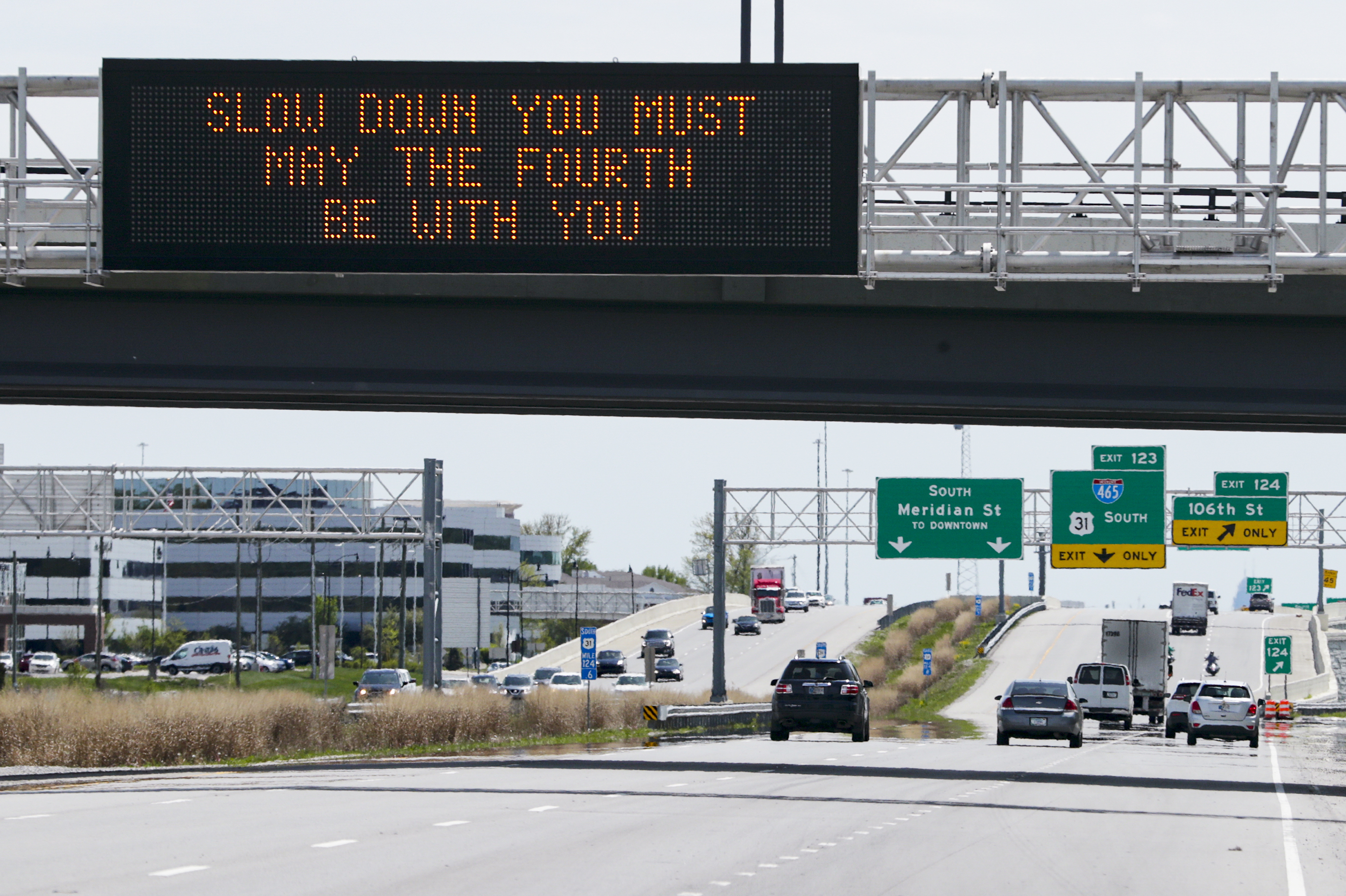
This sign seen in 2020 in Carmel, Indiana along with several others throughout the state, displayed humorous messages for May the Fourth.
Michael Conroy / AP
It could be the end of the road for some of those funny, punny one-liners that states have been putting on electronic freeway signs. The Federal Highway Administration has new rules about those displays.
Over the years, the FHA has flagged signs it said could cause confusion. In rules issued last month, the agency gives states two years to phase out signs that have "obscure" meanings or use pop-culture references that could require drivers "greater time to process." It's not an outright ban on humor but, in a statement, the agency said states "are expected to exercise good judgment."
Safety messages for drivers have long been serious, with some attempts to be catchy. "Click it or ticket," about buckling seat belts, has been around for decades, as has "drive sober or get pulled over."
But in the last several years, states have been using electronic billboards that show traffic and weather alerts or to promote buckling seat belts, obeying the speed limit and not driving impaired. Sometimes they ramp up their messages with a little more zip.
In Arizona, drivers around July 4th have seen the message: "Only sparklers should be lit." Around Halloween, "Hocus pocus – drive with focus," was featured in Texas.
And in Ohio, there was this holiday advice: "Visiting in-laws? Slow down, get there late."
"When I tell people I work at ODOT, a lot of times the first question they ask me is, 'Well, are you the guy that does the signs?'" said Matt Bruning, press secretary for the Ohio Department of Transportation, which has been using humorous messages since 2015.
"And it's funny when they'll quote off some that they remember. I mean, that's what we're trying to do. We're trying to get those safety messages through to people, things that we already know."
Signs can be useful reminders. An FHA study in June 2016 showed 54% of drivers reported changing behaviors after seeing specific messages on electronic signs on roadways.
But repeated phrases can feel stale after a while so some states started revving up those messages to make them more memorable.
Now Bruning says the FHA is putting the brakes on with an update to its manual on those signs.
"We need to limit references to pop culture that maybe aren't widely understood. It also encourages us to make sure that any reference we put up is widely understood," Bruning said.
As an example, he describes a message about wearing seat belts that went up a few years ago – a reference to an often-quoted mispronunciation in a scene from A Christmas Story, a 1983 movie filmed mostly in Cleveland.
"'Life is fragile' and we spelled it out 'fra-gee-lay," Bruning said. "And we thought, man, everybody's seen 'A Christmas Story,' especially in Ohio. Everyone will get that. There are a lot of people who didn't. Unfortunately, they didn't know what we were trying to say. We got some confused phone calls and emails and so we won't use that one again."
New Jersey also went down the funny route, putting up messages that included "Hold on to your butts. Help prevent forest fires," and "We'll be blunt. Don't drive high." The state's department of transportation posted on social media that drivers need to stop taking photos of funny signs or "we will turn this car around and go back to the old messages."
The FHA ordered New Jersey to take down those messages in 2022, but the state brought back the funny displays in November.
Messages to drivers about safety are useful, says Tripp Shealy, an associate professor of civil engineering at Virginia Tech. He led a study in 2020 of how signs on highways can affect behavior.
Shealy says signs that played with words or sought to be funny while still hitting a specific message made drivers think, and therefore were effective.
“Something that’s funny with a behavior change [suggestion] of ‘Be safe’ is not very specific,” he says. “What do you do with that, right? But ‘Get your head out of your apps’ is word play, humor, and very direct, right? Don’t look at your phone.’”
About the new rules, the FHA said in a statement: "The safety of all road users is the priority. The Federal Highway Administration supports the use of changeable message signs, which are operated by state transportation departments, in conjunction with traffic safety campaign – and states are expected to exercise good judgment in how and when they use changeable message signs for traffic safety messages, and in their specific wording of the messages."
Copyright 2024 NPR. To see more, visit https://www.npr.org.